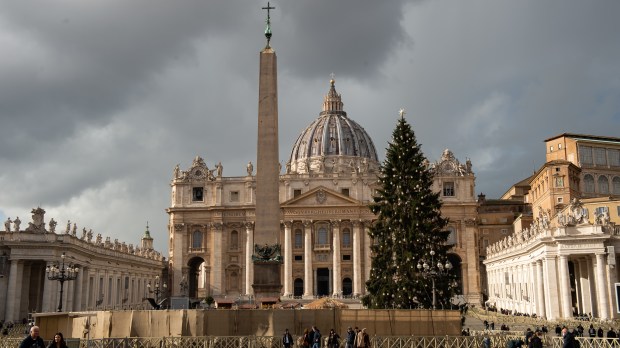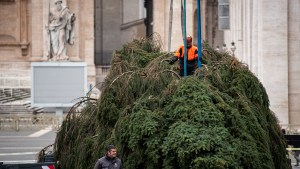Christmas at the Vatican did not always include a giant tree erected in the middle of St. Peter’s Square. It took a Polish pope to introduce the custom, which is now an annual Vatican tradition.
St. John Paul II loved Christmas, especially all the traditions that came from his native land of Poland. A friend of John Paul II explains in the book Stories About Saint John Paul II by Wlodzimierz Redzioch that “The Holy Father was very anxious for us to celebrate the holidays in a family atmosphere, according to the Polish traditions … The Holy Father liked the Christmas tree very much.”
Only recently have Italians embraced the Christmas tree tradition, as before the 20th century it was chiefly a tradition of the northern European countries. This is why it took a Polish pope to introduce the tradition at the Vatican.
The traditions also helped connect him in solidarity to his native Poland, which was under martial law from 1981-1983. In 1981 he adopted the custom of placing a candle in his window during the Advent and Christmas seasons to signify his closeness to the Polish people under oppression in his native land.
Later on in 1999 John Paul II explained the symbolism of the Christmas tree in an address to pilgrims from the Czech Republic.
The Christmas tree, with the crib, creates a typical Christmas atmosphere and can help us understand better the message of salvation that Christ came to bring us through his Incarnation.
From the stable of Bethlehem to the Cross on Golgotha, with his whole life he bore witness to God’s love for mankind. He is, according to the Evangelist John, “the true light that enlightens every man” (1:9).
The lights sparkling on the Christmas tree symbolize this Light, to strengthen our knowledge of the great mystery: in Christ is the light that can change the human heart.
He expressed his fondness for trees in an address in 2000 and how he enjoys seeing it from his window.
In the past few days, every time I have looked out of my study window at St Peter’s Square the tree has uplifted my spirit. I always loved trees in my homeland. When one looks at them, in a certain way they begin to speak. One poet considers trees as preachers with a profound message: “They do not preach doctrines or precepts, but announce the fundamental law of life.”
In 2004, John Paul II recalled the symbolism of the Christmas tree as a sign of eternal life.
Next to the crib, as in St Peter’s Square, we find the traditional “Christmas tree.” This too is an ancient tradition that exalts the value of life, for in the winter season the evergreen fir becomes a sign of undying life. Christmas gifts are usually placed on the tree or arranged at its base. The symbol thus also becomes eloquent in a typically Christian sense: it calls to mind the “tree of life” (cf. Gn 2: 9), a figure of Christ, God’s supreme gift to humanity.
The message of the Christmas tree is consequently that life stays “evergreen” if we make a gift of it: not so much of material things, but of life itself: in friendship and sincere affection, in fraternal help and forgiveness, in time shared and reciprocal listening.
Nearly 40 years later, the Christmas tree continues to be a powerful image in St. Peter’s Square, all due to a homesick pope, wanting to celebrate Christmas as he did back home.



